| Cap. 8. Combining Images | ||
|---|---|---|

|
Parte II. How do I Become a GIMP Wizard? |  |
Cuprins
Vă puteți gândi la straturi ca un teanc de diapozitive. Folosind straturi, puteți construi o imagine din mai multe piese conceptuale, oricare dintre ele putând fi manipulate fără a afecta orice altă parte a imaginii. Straturile sunt stivuite unul peste altul. Stratul de jos este fundalul imaginii, iar componentele din prim-plan ale imaginii vin deasupra.
There is no limit to the number of layers an image can have, only the amount of memory available on the system. It is not uncommon for advanced users to work with images containing dozens of layers. You can group layers to make your work easier, and there are many commands to handle layers.
The organization of layers in an image is shown in the Layers dialog, which is the second most important type of dialog window in GIMP, after the Main Toolbox. How it works is described in detail in the Layers Dialog section, but we will touch some aspects of it here, in relation to the layer properties that they display.
Each open image has at any time a single active drawable. A „drawable” is a GIMP concept that includes layers, but also several other items, such as channels, layer masks, and the selection mask. Basically, a „drawable” is anything that can be drawn on with painting tools. If a layer is currently active, it is shown highlighted in the Layers dialog, and its name is shown in the status area of the image window. If not, you can activate it by clicking on it. If none of the layers are highlighted, it means the active drawable is something else than a layer.
In the menu bar, you can find a menu called , containing a number of commands that affect the active layer of the image. The same menu can be accessed by right-clicking in the Layers dialog.
Fiecare strat dintr-o imagine are o serie de atribute importante:
Every layer has a name. This is assigned automatically when the layer is created, but you can change it. You can change the name of a layer either by double-clicking on it in the Layers dialog, or by right-clicking there, and then selecting the top entry in the menu that appears, .
An alpha channel encodes information about how transparent a layer is at each pixel. It is visible in the Channel Dialog: white is complete opacity, black is complete transparency and gray levels are partial transparencies.
The background layer is special. If you have just created a new image, it only has one layer, which is the background layer. If the image has been created with an opaque Fill type, this one layer has no Alpha channel. To get a background layer with transparency, either create your new image with a transparent Fill type, or you use the Add an Alpha Channel command.
If you add a new layer, even with an opaque Fill type, an Alpha channel is automatically added to the layer.
Every layer other than the bottom layer of an image automatically has an Alpha channel, but you can't see a grayscale representation of the alpha values. See Alpha in Glossary for more information.
Fig. 8.2. Exemplu canal alfa: imagine de bază
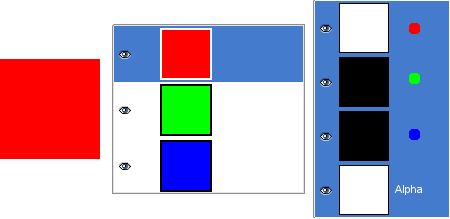
This image has three layers painted with pure 100% opaque Red, Green, and Blue. In the Channel Dialog, you can see that an alpha Channel has been added. It is white because the image is not transparent since there is at least one 100% opaque layer. The current layer is the red one: since it is painted with pure red, there is no green and no blue and the corresponding channels are black.
Fig. 8.3. Exemplu de canal Alfa: un strat transparent
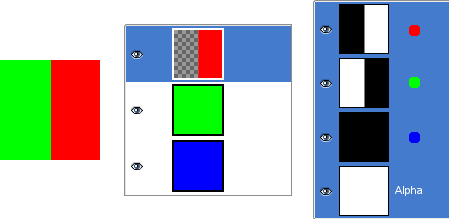
Partea stângă a primului strat a fost făcută transparentă (selecție dreptunghiulară, Editare/Golire). Al doilea strat, verde, este vizibil. Canalul alfa este încă alb, deoarece există un strat opac în această parte a imaginii.
Fig. 8.4. Exemplu de canal Alfa: două straturi transparente
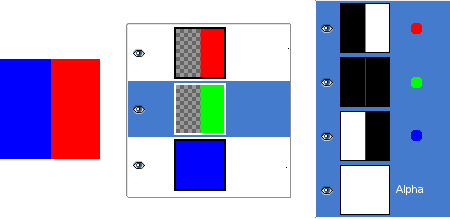
Partea stângă a celui de-al doilea strat a fost făcută transparentă. Al treilea strat, albastru, este vizibil prin primul și al doilea strat. Canalul alfa este încă alb, deoarece există un strat opac în această parte a imaginii.
Fig. 8.5. Exemplu de canal Alfa: trei straturi transparente
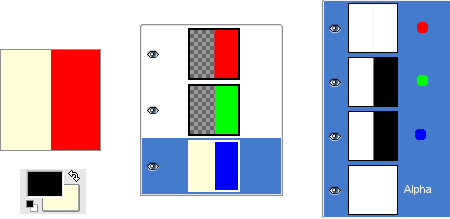
The left part of the third layer has been cleared. The Alpha channel is still white and the left part of the layer is opaque, because the background layer has no Alpha channel. In this case, the Clear command works like the Eraser and uses the Background color of Toolbox.
Fig. 8.6. Exemplu de canal Alfa: canal Alfa adăugat la fundal
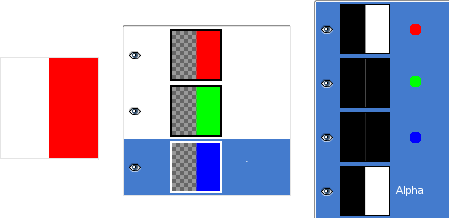
We used the → → command, on the Background layer. Now, the left part of the image is fully transparent and has the color of the page where the image is shown. The left part of the Alpha Channel thumbnail is black (transparent) in the Channel Dialog.
The layer type is determined by the image type (see previous section), and the presence or absence of an alpha channel. These are the possible layer types:
RGB
RGBA
Gri
GriA
Indexat
IndexatA
The main reason this matters is that some filters (in the menu) only accept a subset of layer types, and appear disabled in the menu if the active layer does not have a supported type. Often you can rectify this either by changing the mode of the image, or by adding or removing an alpha channel.

Este posibil să eliminați un strat dintr-o imagine, fără a-l pierde, apăsând clic pe simbolul din dialogul straturi. Aceasta se numește „comutarea vizibilității” stratului. Majoritatea operațiilor pe o imagine tratează straturile comutate ca și cum nu ar exista. Când lucrați cu imagini care conțin mai multe straturi, cu opacitate variabilă, deseori puteți obține o imagine mai bună a conținutului stratului la care doriți să lucrați ascunzând unele dintre celelalte straturi.
![[Indicație]](images/tip.png)
|
Indicație |
|---|---|
|
Cu Shift+clic pe simbolul ochiului, vor fi ascunse toate straturile cu excepția cel pe care apăsați clic. |
Usually, you activate a layer, to work on it, clicking it in the layer list. When you have a lot of layers, finding which layer an element of the image belongs to is not easy: then, press Alt and click with Mouse wheel on this element to activate its layer. The available layers will be looped through (starting from the upper one) while the Alt is held and the picked layer will be temporarily displayed in the status bar.
 Legătura cu alte straturi
Legătura cu alte straturi
Dacă apăsați clic între pictograma ochi și miniatura stratului, veți obține o pictogramă lanț, care vă permite să grupați straturi pentru operații pe mai multe straturi (de exemplu cu instrumentul mutare sau cu instrumentul transformare).
In GIMP, the boundaries of a layer do not necessarily match the boundaries of the image that contains it. When you create text, for example, each text item belongs to its own separate layer, and the layer size is automatically adjusted to contain the text and nothing more. Also, when you create a new layer using cut-and-paste, the new layer is sized just large enough to contain the pasted item. In the image window, the boundaries of the currently active layer are shown outlined with a black-and-yellow dashed line.
Principalul motiv pentru care acest lucru este important este că nu puteți face nimic unui strat în afara limitelor sale: nu puteți acționa pe ceea ce nu există. Dacă acest lucru vă cauzează probleme, puteți modifica dimensiunile stratului utilizând oricare dintre comenzile pe care le puteți găsi în partea de jos a meniului .
![[Notă]](images/note.png)
|
Notă |
|---|---|
|
Cantitatea de memorie pe care un strat o consumă este determinată de dimensiunile sale, nu de conținut. Deci, dacă lucrați cu imagini mari sau imagini care conțin mai multe straturi, s-ar putea economisi prin decupare la dimensiunea minimă posibilă. |
Opacitatea unui strat determină măsura în care se permite culorilor din straturile de dedesubt să fie afișate. Opacitatea variază de la 0 la 100, cu 0 reprezentând transparență completă, și 100 pentru opacitate completă.
Modul unui strat determină felul în care culorile din strat sunt combinate cu culori din straturile subiacente pentru a produce un rezultat vizibil. Acesta este un concept suficient de complex și suficient de important pentru a merita o secțiune proprie, care urmează. Consultați Secțiune 2, „Moduri straturis”.
În plus față de canalul Alfa, există un alt mod de a controla transparența unui strat: adăugând o mască strat, care constă din extra tonuri de gri, ce pot fi asociate stratului. Un strat nu are o mască strat implicită: trebuie adăugată în mod specific. Măștile strat, și modul de lucru, sunt descrise mult mai pe larg în secțiunea Mască strat.